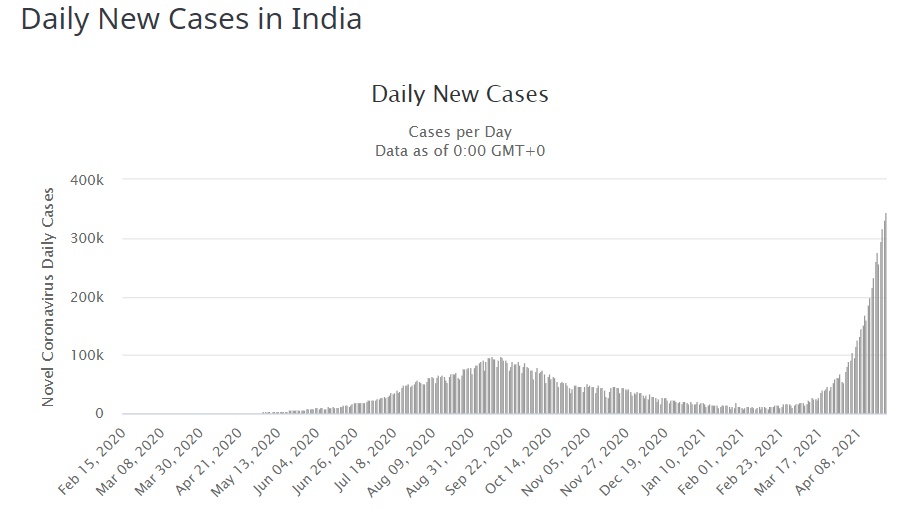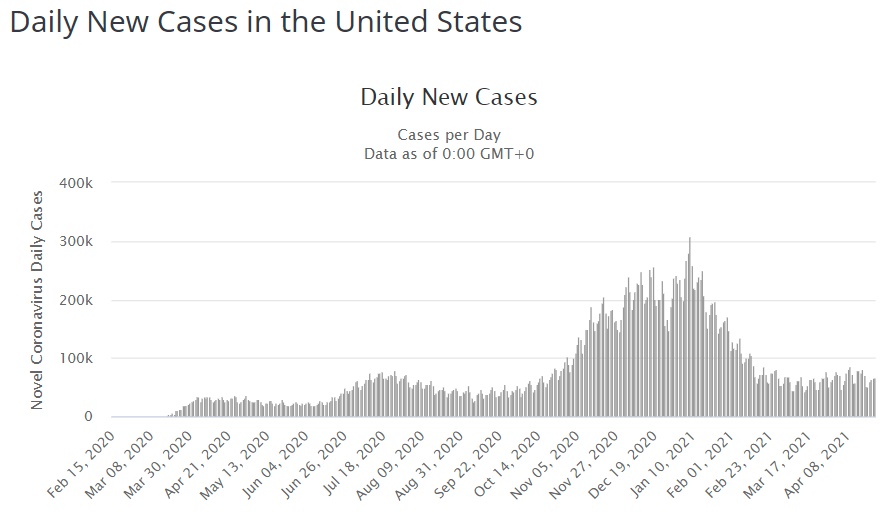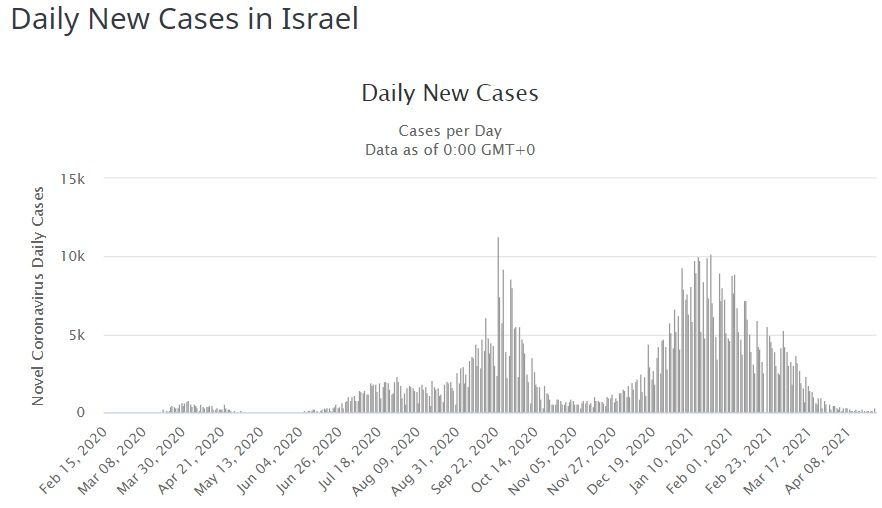On Friday, the panel of outside advisors at the CDC recommended that Johnson & Johnson’s COVID-19 vaccine be made available, with the addition of a warning label drawing attention to its possible connection to a cluster of extremely rare blood clot cases. In response, both the CDC and FDA reacted quickly, and by Friday night the one-shot vaccine was once again shipping out to locations across the nation.
Even though increased production of the Pfizer/BioNTech and Moderna vaccines meant that few locations actually saw a shortfall following the “pause” in delivering of the Johnson & Johnson vaccine, its return to the mix has benefits. The easy storage of the vaccine makes it possible to administer at small clinics and pharmacies that lack the cold storage necessary for the other authorized vaccines. Also, the fact that the Johnson & Johnson vaccine requires just a single dose makes it much more convenient for those who have to get off work in order to get a vaccine, or those who have to travel some distance to reach a vaccination location.
Undoubtedly, there will be some continued resistance to getting the Johnson & Johnson vaccine from the lasting perception that it’s more dangerous than other types. However, the number of blood clot incidents was tiny, and the connection is still not certain (and while other medications, such as birth control pills, are associated with more clotting incidents, there are reasons why the two are not directly comparable).
Even as J&J returns to a needle near you, risk in the United States is shifting away from vaccine availability and toward vaccine hesitancy. That may mean that the U.S. hovers in a space between the point where the number of those vaccinated prevents an explosive “fourth wave,” but not enough people are vaccinated to ever really bring the pandemic to a close.
In a global sense, not only is the pandemic not getting better, it’s getting worse. The biggest day yet recorded for new cases of COVID-19 was Friday, when the world logged over 897,000 positive results. The biggest source of those cases was India, which racked up 345,000 cases as it broke the old U.S. record for most cases in a day for the third day running. India also broke its own record for the largest number of COVID-19 deaths in a single day, reporting 2,600. There are good reasons to think that number is far from accurate, though.
As The New York Times reports, COVID-19 deaths in India are being “overlooked or downplayed” in massive numbers. Both the number of cases and the number of deaths being logged are drastically underreporting the real spread and impact of the disease in India. Researchers at the University of India estimate that the true number of deaths is two to five times greater than the official values. Crematoriums are running 24/7 and still can’t come close to keeping up with demand. Mass cremations are being conducted in parking lots.
Despite the huge growth in cases that has taken India to the #2 slot on the all-time list, only 1.2% of the population has officially tested positive so far. COVID-19 has almost infinite growth potential in India. Which is horrifying. As CNN reports, patients who would normally survive their bout with the coronavirus are dying because there is a shortage of ventilators, oxygen, and even simple hospital beds. With the case count still rising every day, this situation can only be expected to get worse.
Throughout the pandemic, about 20% of patients have required hospital care. With appropriate care, the great majority of those patients survive, leaving COVID-19 with an overall case fatality rate between 1- 2%. But the more overwhelmed a healthcare system becomes, the more the fatality rate approaches the hospitalization rate. That’s what happened in the U.S. when the disease first appeared in the Northeast. It’s what has happened many times since then in places like Manaus, Brazil. It’s what’s happening now in India … only the scale has changed.
All of this is happening months after much of the world seems to have passed the peak of the pandemic, and where vaccination programs in many countries are reaching a point where they can have a genuine impact on the spread of disease. And it’s coming after India seems to do a fairly remarkable job in restricting the spread of COVID-19 through the first months of pandemic. However, Indian Prime Minister Narendra Modi has engaged in some Donald Trump-like downplaying of the threat over recent months. Enforcement of social distancing guidelines has largely been dropped, mask mandates are ignored, and large social and religious gatherings are actively encouraged.
Also, the U.S. is not alone in dealing with vaccine hesitancy. As NPR reported in March, skepticism about the vaccine resulted in low turnout at vaccination events in India. Local media focused on a small number of deaths that happened after vaccinations—deaths that had no established ties to the vaccinations themselves—and on people who got COVID-19 after being vaccinated, without explaining the time required for the vaccination to work. Combine that issue with a bumbled vaccine rollout, and, despite being a major center of vaccine manufacture, India has managed to vaccinate just 8% of its population.
In India, a fumbled distribution program and extremely high vaccine skepticism have limited vaccination to about 8% of the adult population, and 2.9% of the overall population. In the face of new variants, relaxed social distancing, and vaccine hesitancy, India is seeing a massive spike in new cases.

New daily cases of COVID-19 in India reflect low levels of vaccination, relaxed guidelines, and new more contagious variants
As of this writing, in the United States, 52% of the adult population has had at least one jab, and 27.5% of the total population has been fully vaccinated. With social distancing being routinely disregarded in many areas, and few mask mandates still in operation, that value alone isn’t enough to seriously suppress the spread of COVID-19, but it may be enough to help prevent the kind of spike in cases being seen in India.

New daily cases of COVID-19 in the United States remain at a high level, but have not yet produced a “fourth wave”
Meanwhile, in Israel, an aggressive vaccination program has reached over 80% of the adult population, or 55% of the total population. This has been paired with continued social distancing guideline enforcement and the government just removed the mask mandate for only outdoor activities in the past week. That combination appears to have pushed the pandemic to the point where it can be dealt with through testing and contact tracing.

New cases of COVID-19 in Israel appear to have been significantly depressed through a widespread campaign of vaccination.
Where cases in India are exploding, and cases in the United States have leveled off at a rate higher than most of 2020, cases in Israel are down to a level not seen in almost a year. The local epidemic isn’t genuinely “over,” but it certainly seems to be on the way to being eliminated.
There’s something of a worldwide experiment going on: What percentage of the population needs to be vaccinated before a nation’s COVID-19 levels drop? However, this experiment isn’t being played on anything like an even field. Some nations, like Israel, have maintained mask mandates and other restrictions, even as vaccines were rolled out. Other nations never imposed such guidelines. Still, with 27% of the population inoculated, COVID-19 rates remain high in the United States. Chile has fully vaccinated 31% of its population, and the number of cases there remain near the country’s all-time high. The United Arab Emirates has fully vaccinated 39% of its population, but the rate of new cases there shows no sign of falling. In fact, no other nation, short of Israel, seems to have brought the disease under control through vaccination—and even there, the enforcement of social distancing guidelines has probably played a major role. It would not be surprising to see cases in Israel actually increase as those restrictions are removed in the coming weeks.
Beyond Israel, there are only a few places where the rate of vaccination is higher, and they’re all too small to really contribute a great deal to the overall analysis. Still, it’s nice to know that in the Falkland Islands (fully vaccinated: 63%) saw just 1 new case in the last week, while on Gibraltar (fully vaccinated: 94%) the total number of COVID-19 cases is where we would all like to be: zero.
Even though increased production of the Pfizer/BioNTech and Moderna vaccines meant that few locations actually saw a shortfall following the “pause” in delivering of the Johnson & Johnson vaccine, its return to the mix has benefits. The easy storage of the vaccine makes it possible to administer at small clinics and pharmacies that lack the cold storage necessary for the other authorized vaccines. Also, the fact that the Johnson & Johnson vaccine requires just a single dose makes it much more convenient for those who have to get off work in order to get a vaccine, or those who have to travel some distance to reach a vaccination location.
Undoubtedly, there will be some continued resistance to getting the Johnson & Johnson vaccine from the lasting perception that it’s more dangerous than other types. However, the number of blood clot incidents was tiny, and the connection is still not certain (and while other medications, such as birth control pills, are associated with more clotting incidents, there are reasons why the two are not directly comparable).
Even as J&J returns to a needle near you, risk in the United States is shifting away from vaccine availability and toward vaccine hesitancy. That may mean that the U.S. hovers in a space between the point where the number of those vaccinated prevents an explosive “fourth wave,” but not enough people are vaccinated to ever really bring the pandemic to a close.
In a global sense, not only is the pandemic not getting better, it’s getting worse. The biggest day yet recorded for new cases of COVID-19 was Friday, when the world logged over 897,000 positive results. The biggest source of those cases was India, which racked up 345,000 cases as it broke the old U.S. record for most cases in a day for the third day running. India also broke its own record for the largest number of COVID-19 deaths in a single day, reporting 2,600. There are good reasons to think that number is far from accurate, though.
As The New York Times reports, COVID-19 deaths in India are being “overlooked or downplayed” in massive numbers. Both the number of cases and the number of deaths being logged are drastically underreporting the real spread and impact of the disease in India. Researchers at the University of India estimate that the true number of deaths is two to five times greater than the official values. Crematoriums are running 24/7 and still can’t come close to keeping up with demand. Mass cremations are being conducted in parking lots.
Despite the huge growth in cases that has taken India to the #2 slot on the all-time list, only 1.2% of the population has officially tested positive so far. COVID-19 has almost infinite growth potential in India. Which is horrifying. As CNN reports, patients who would normally survive their bout with the coronavirus are dying because there is a shortage of ventilators, oxygen, and even simple hospital beds. With the case count still rising every day, this situation can only be expected to get worse.
Throughout the pandemic, about 20% of patients have required hospital care. With appropriate care, the great majority of those patients survive, leaving COVID-19 with an overall case fatality rate between 1- 2%. But the more overwhelmed a healthcare system becomes, the more the fatality rate approaches the hospitalization rate. That’s what happened in the U.S. when the disease first appeared in the Northeast. It’s what has happened many times since then in places like Manaus, Brazil. It’s what’s happening now in India … only the scale has changed.
All of this is happening months after much of the world seems to have passed the peak of the pandemic, and where vaccination programs in many countries are reaching a point where they can have a genuine impact on the spread of disease. And it’s coming after India seems to do a fairly remarkable job in restricting the spread of COVID-19 through the first months of pandemic. However, Indian Prime Minister Narendra Modi has engaged in some Donald Trump-like downplaying of the threat over recent months. Enforcement of social distancing guidelines has largely been dropped, mask mandates are ignored, and large social and religious gatherings are actively encouraged.
Also, the U.S. is not alone in dealing with vaccine hesitancy. As NPR reported in March, skepticism about the vaccine resulted in low turnout at vaccination events in India. Local media focused on a small number of deaths that happened after vaccinations—deaths that had no established ties to the vaccinations themselves—and on people who got COVID-19 after being vaccinated, without explaining the time required for the vaccination to work. Combine that issue with a bumbled vaccine rollout, and, despite being a major center of vaccine manufacture, India has managed to vaccinate just 8% of its population.
A tale of three levels of vaccination
In India, a fumbled distribution program and extremely high vaccine skepticism have limited vaccination to about 8% of the adult population, and 2.9% of the overall population. In the face of new variants, relaxed social distancing, and vaccine hesitancy, India is seeing a massive spike in new cases.

New daily cases of COVID-19 in India reflect low levels of vaccination, relaxed guidelines, and new more contagious variants
As of this writing, in the United States, 52% of the adult population has had at least one jab, and 27.5% of the total population has been fully vaccinated. With social distancing being routinely disregarded in many areas, and few mask mandates still in operation, that value alone isn’t enough to seriously suppress the spread of COVID-19, but it may be enough to help prevent the kind of spike in cases being seen in India.

New daily cases of COVID-19 in the United States remain at a high level, but have not yet produced a “fourth wave”
Meanwhile, in Israel, an aggressive vaccination program has reached over 80% of the adult population, or 55% of the total population. This has been paired with continued social distancing guideline enforcement and the government just removed the mask mandate for only outdoor activities in the past week. That combination appears to have pushed the pandemic to the point where it can be dealt with through testing and contact tracing.

New cases of COVID-19 in Israel appear to have been significantly depressed through a widespread campaign of vaccination.
Where cases in India are exploding, and cases in the United States have leveled off at a rate higher than most of 2020, cases in Israel are down to a level not seen in almost a year. The local epidemic isn’t genuinely “over,” but it certainly seems to be on the way to being eliminated.
There’s something of a worldwide experiment going on: What percentage of the population needs to be vaccinated before a nation’s COVID-19 levels drop? However, this experiment isn’t being played on anything like an even field. Some nations, like Israel, have maintained mask mandates and other restrictions, even as vaccines were rolled out. Other nations never imposed such guidelines. Still, with 27% of the population inoculated, COVID-19 rates remain high in the United States. Chile has fully vaccinated 31% of its population, and the number of cases there remain near the country’s all-time high. The United Arab Emirates has fully vaccinated 39% of its population, but the rate of new cases there shows no sign of falling. In fact, no other nation, short of Israel, seems to have brought the disease under control through vaccination—and even there, the enforcement of social distancing guidelines has probably played a major role. It would not be surprising to see cases in Israel actually increase as those restrictions are removed in the coming weeks.
Beyond Israel, there are only a few places where the rate of vaccination is higher, and they’re all too small to really contribute a great deal to the overall analysis. Still, it’s nice to know that in the Falkland Islands (fully vaccinated: 63%) saw just 1 new case in the last week, while on Gibraltar (fully vaccinated: 94%) the total number of COVID-19 cases is where we would all like to be: zero.